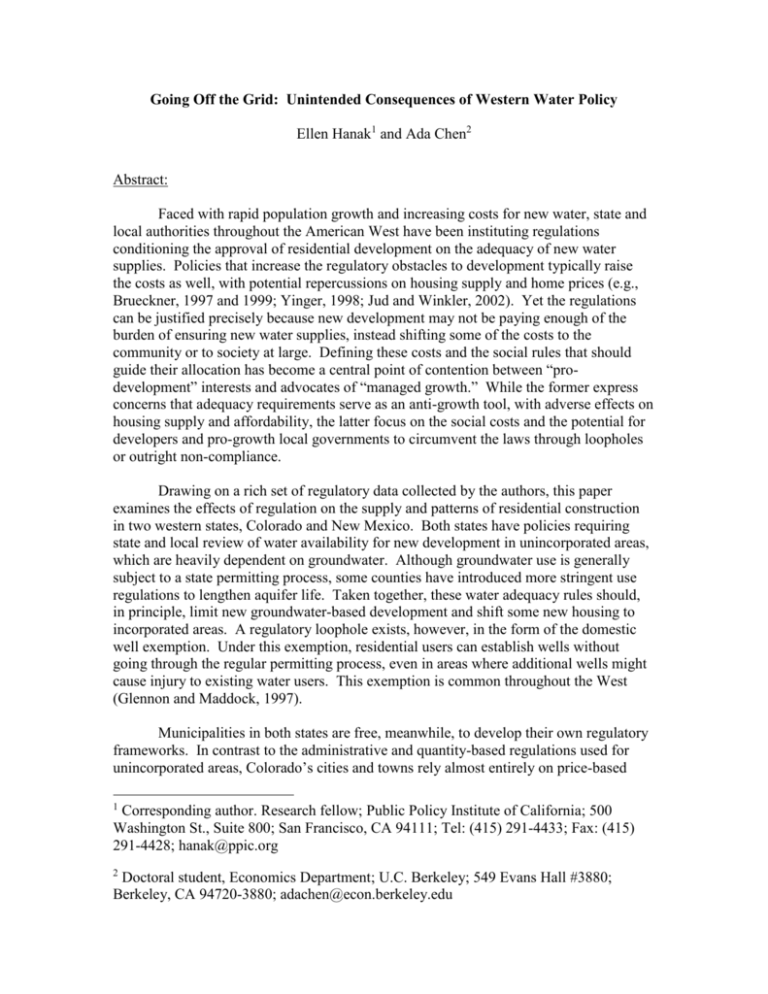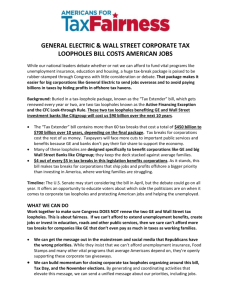Going Off the Grid: Unintended Consequences of Western Water
advertisement

Going Off the Grid: Unintended Consequences of Western Water Policy Ellen Hanak1 and Ada Chen2 Abstract: Faced with rapid population growth and increasing costs for new water, state and local authorities throughout the American West have been instituting regulations conditioning the approval of residential development on the adequacy of new water supplies. Policies that increase the regulatory obstacles to development typically raise the costs as well, with potential repercussions on housing supply and home prices (e.g., Brueckner, 1997 and 1999; Yinger, 1998; Jud and Winkler, 2002). Yet the regulations can be justified precisely because new development may not be paying enough of the burden of ensuring new water supplies, instead shifting some of the costs to the community or to society at large. Defining these costs and the social rules that should guide their allocation has become a central point of contention between “prodevelopment” interests and advocates of “managed growth.” While the former express concerns that adequacy requirements serve as an anti-growth tool, with adverse effects on housing supply and affordability, the latter focus on the social costs and the potential for developers and pro-growth local governments to circumvent the laws through loopholes or outright non-compliance. Drawing on a rich set of regulatory data collected by the authors, this paper examines the effects of regulation on the supply and patterns of residential construction in two western states, Colorado and New Mexico. Both states have policies requiring state and local review of water availability for new development in unincorporated areas, which are heavily dependent on groundwater. Although groundwater use is generally subject to a state permitting process, some counties have introduced more stringent use regulations to lengthen aquifer life. Taken together, these water adequacy rules should, in principle, limit new groundwater-based development and shift some new housing to incorporated areas. A regulatory loophole exists, however, in the form of the domestic well exemption. Under this exemption, residential users can establish wells without going through the regular permitting process, even in areas where additional wells might cause injury to existing water users. This exemption is common throughout the West (Glennon and Maddock, 1997). Municipalities in both states are free, meanwhile, to develop their own regulatory frameworks. In contrast to the administrative and quantity-based regulations used for unincorporated areas, Colorado’s cities and towns rely almost entirely on price-based 1 Corresponding author. Research fellow; Public Policy Institute of California; 500 Washington St., Suite 800; San Francisco, CA 94111; Tel: (415) 291-4433; Fax: (415) 291-4428; hanak@ppic.org 2 Doctoral student, Economics Department; U.C. Berkeley; 549 Evans Hall #3880; Berkeley, CA 94720-3880; adachen@econ.berkeley.edu regulation, by charging water impact fees to cover the costs of developing new water supplies. Fees in the rapidly growing Front Range are substantial, often exceeding 3 percent of median home values. This practice is more nascent in New Mexico. There is little doubt that these fees are carried over, at least in part, to home prices (see Ihlanfeldt and Shaunessy, 2004 for a recent review of the literature). However, the effects on housing supply are less clear; as long as fees are levied for a service, they are not considered a tax, and should not distort housing demand. They might, however, be expected to shift development to lower-cost areas. Our framework of analysis is the model of housing supply developed by Mayer and Somerville (2000a and b), which they use to estimate the impact of growth controls in 44 MSAs. Hanak (2005) used this framework to examine the effects of local water screening policies on housing supply in California’s local jurisdictions since the mid1990s and found that these regulations significantly slow growth. Here, we use two measures of annual housing supply as the dependent variable: jurisdiction-specific residential construction permits (a measure of total housing construction) and countylevel data on domestic wells (a measure of housing built “off the grid” of the local water utilities). Using fixed-effects panel regressions covering the years 1990 to 2003, we find that development is very sensitive to the imposition of quantity restrictions and administrative review. In both states, the introduction of new regulations in unincorporated areas has shifted some development to cities and towns, arguably an intended policy outcome. However, regulation has also encouraged a substantial increase in development off the grid, an unintended result owing to the domestic well loophole. Meanwhile, increases in water impact fees, measured either in percentage or level terms, do not appear to depress municipal housing supply; nor do fee changes appear to cause a shift to neighboring jurisdictions or to unincorporated areas. These findings are consistent with results from Hanak’s California study, as well as Mayer and Somerville’s national study, which found that the presence of impact fees did not significantly slow growth. The paper provides compelling evidence that administrative reviews and quantity restrictions shift development in ways that may be undesirable if loopholes are available. Domestic well exemptions, initially introduced as a way to facilitate water access for homesteaders in remote areas, now threaten the optimal management of groundwater basins. Rapid well-based development is also likely to generate other environmental costs, including a proliferation of septic systems and the loss of open space associated with ex-urban growth. Our results suggest, however, that when the loopholes are closed, regulation in groundwater-dependent areas can encourage more growth in urbanized areas, which can benefit from scale economies in water supply development. Meanwhile, the lack of a clear depressive effect of impact fees on housing suggests that price-based tools are a good regulatory alternative to quantity restrictions. References: Brueckner, Jan K., 1997. “Infrastructure Financing and Urban Development: The Economics of Impact Fees,” Journal of Public Economics, Vol. 66, pp. 383-407. Brueckner, Jan K., 1999. “Modeling Urban Growth Controls,” in Panagariya, Arvind, Portney, Paul R., Schwab, Robert M. (eds.), Environmental and Public Economics: Essays in Honor of Wallace E. Oates, Cheltenham, U.K.: Elgar. Glennon, Robert J.G. and Tomas Maddock, III, 1997. “The Concept of Capture: The Hydrology and Law of Stream/Aquifer Interactions,” Proceedings of the Forty-Third Annual Rocky Mountain Mineral Law Institute, Denver, CO. Hanak, Ellen, 2005. “Is Water Policy Limiting Residential Growth? Evidence from California,” Working Paper No. 2005.01, Public Policy Institute of California, San Francisco, CA, March. Ihlanfeldt, Keith R. and Timothy M. Shaughnessy, “An Empirical Investigation of the Effects of Impact Fees on Housing and Land Markets,” Regional Science and Urban Economics, 2004. Jud, G. Donald and Daniel T. Winkler, 2002. “The Dynamics of Metropolitan Housing Prices,” Journal of Real Estate Research, Vol. 23 (1/2), pp. 29-45. Yinger, John, 1998. “The Incidence of Development Fees and Special Assessments,” National Tax Journal, Vol. 51(1), pp. 23-41.











